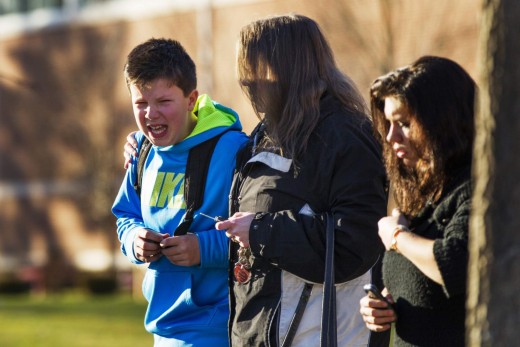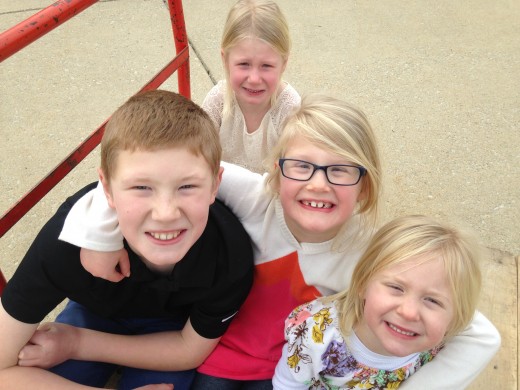Grieving Children; Talking to Kids About Tragedy and Death and Guiding Them in Grieving Circumstances
How to Comfort When Tragedy Strikes

Conversations with Children about Tragedy
Our world, our community, and sometimes even our core families can be fragile places. By that I mean these places can involve situations that show uncertainty, confusion, and sometimes fear to children.
Lately, our world has seemed a little less stable, much more vulnerable. Hatred, pain, and purposeful killing is commonplace. Even if they can't grasp the meaning, terrorism is a word that most children have heard.
So, how do the youngest respond to tragedy? How can you as a parent, caregiver, or teacher discuss these difficult topics to the youngest citizens in honest, yet sensitive ways?
The purpose of this article is to give you some ideas and options for conversations with children about tragedy that has happened or is currently happening in our world.

Idea One: Look for Clues
Sitting a child down for a formal, "We need to talk about something important" type family meeting or one-on-one discussion can be a nerve racking experience for you and/or the child. I recommend spending some time with the young person before gently guiding conversation into a heavier topic of talk.
Suggestions:
1. Look for visible signs of confusion or fear.
Is your child acting nervous or fearful? Tears, withdrawal, hiding, shyness, all are signs that the child is internally processing.
If these signs are noticed, I suggest (when appropriate) a hug, a hand on the shoulder, or maybe a squeeze of the hand. For very small children, scooping up the child and holding him or her may be a comforting start to your interaction. These quiet gestures send the message, "I am here with you" and "I am available to you if you need me."
2. Listen.
If your child is of school age or has been in a situation where he or she has most likely heard the devastating news already, please take the time to LISTEN BEFORE TALKING.
Your child may be extremely quiet, or may appear overly talkative. Either extreme is a quite normal response.
Is your child quiet or withdrawing from you or others? Perhaps he or she is trying to piece together information that has been heard or overheard.
suggestions: ask questions like, "What is on your mind?" or "Is there something that is bothering you?" For older children, it is appropriate to ask, "What are your thoughts about the tragedy that happened?"
Is your child talking endlessly about the tragedy? Does he or she seem to be drawing conclusions that may or may not be based on truth?
suggestions: ask questions like, "Where did you hear your information?" "Can we talk about this together and try to figure out the facts?" It is important for all of us, children included, to process these situations rationally. People may be quick to jump to conclusions out of fear or confusion or maybe they just plain heard (or overheard) the wrong facts. Talk through the happening step-by-step, honestly, but using concrete facts. Try not to focus on emotional details at this point. It is important to have the right facts first, or their thought process may jump to irrational conclusions.
Idea Two: Pay Attention to the Child
Sometimes as adults, we overcomplicate things by having a very detailed "agenda" when dealing with kids. Sometimes kids are simpler than we think: they may just need the facts, need to know the school's/family's next step in dealing with the situation, and then the processing can begin. Other children may need more help: longer, more detailed conversations, conversations involving other people (siblings, other trusted family friends, or even a counselor, or professional trained in grief response).
Pay attention to what your child is doing and saying. Adapt accordingly.
Suggestions: If your child is clinging to you, be available to talk or comfort, but don't feel like you need to bring up the devastating topic over and over again.
If your child or the child you are dealing with is overly emotional, and this continues for an extended amount of time, involving other people in the care of the child might be an important step.
If your child doesn't want to discuss the situation, but you know he or she is being affected, try giving your child a creative outlet to share his or her thoughts and feelings. Consider giving paper, pens, paints, chalk, crayons, or even play dough to the child and asking him or her to show you what they are feeling. Allow them the freedom of time and media, and give them space while they do this. Hovering and pestering with questions while they create is not allowed. After the child is finished, ask him or her if they'd like to share their piece with you. Do not be pushy and try to make this something more complicated than it is. Pay attention to details of colors used, facial expressions of the characters/people drawn, and pay attention to the words the child uses to describe what they have done. Don't make this into your agenda, observe. Listen. Be kind, refraining from criticism or using words like, "well, you also could have done this or that". Remember, the purpose of this activity is to try to understand your child better, not to critique an art work or create a perfectionistic view of what you are thinking about. You are focusing on them, not you.
If your child is older, say old enough to text or call, consider calling or texting your child about the topic while he or she is in a different room of the house as you. I do not, I repeat, do not advise conversing about such things while the child is away from your home. This activity's purpose is to engage with your child in a nonthreatening way-- a way in which he or she has space and freedom to communicate, but also has the availability to physically be with you if that is wanted.
Suggestion: send a text or call your child asking a simple question such as, "Would you like to talk about what happened today?" Your child can feel the freedom to think for a moment before responding with this approach. Also, the separation may help the child feel more freedom or ease or honesty when expressing their thoughts than, say, if you were in the same room with them, looking concerned or waiting in awkward silence. You might be pleasantly surprised to notice how open your child is to this technique: you are showing your concern, but you are not overbearing or forcing communication. You are allowing your child to communicate in a vulnerable way, in a personal way, without the stress and hardship that sometimes a face-to-face talk can bring.
If your child says he/she does not want to discuss the happening, respect their thoughts and allow them time. Perhaps deliver a drink to their room 2 hours later, plop down on their bed, and remind them you care about them and are willing to talk when they are ready. Don't be pushy. This makes most children, especially ones who are hurting or afraid, clam up and avoid you. Children can sense when you are genuinely concerned and appreciate when you take into consideration their thoughts and feelings. Time and space, but with a gentle reminder that you are available can show your love more than hovering and being pushy. No one likes to be pestered, not even children, take their personality and demeanor into consideration when choosing how to communicate with them. Respectful interactions go a long way in leading to vulnerable and difficult conversations.

Idea Part 3: Consider Who Should be Talking to Your Child
Consideration of who should be present in your home or who should be talking to your child about the incident is important. If your tragedy involved a family member, perhaps having several family members surrounding you in your time of grief would be comforting. If your tragedy involved a group that your child is a part of (such as a team or a musical group or a church youth group), you should be aware of the steps being taken to help your child grieve with the involved group.
If your child is grieving a situation that happened in a group in which you are not an active participant (such as a sports team), be careful to avoid statements such as, "I know exactly how you are feeling" or "I know how he or she (person involved) would want you to react to this". Using such statements will frustrate your child. Even though you are trying to relate to your child's specific feelings, how can you fully relate if you are not a part of the community, team, or group on the "front lines" of the situation? Because you can't fully understand the depths of the relationships you are not a part of, it is a good idea to figure out ways that your child can grieve or spend time with the others directly affected. Sometimes this means a group meeting as a team or a student meeting led by a teacher or administrator. School staff are trained to help your child in most crisis situations involving groups of the student body, so stay in tune with the involvement of counselors and coaches in the process and, when appropriate, allow your child to engage in this important way.
Please attend to your child first. Listen. Ask questions. Be available. These are the most important things you can do to show you care.
Please do not immediately call others to rehash events or spend time on electronic devises discussing what has happened. There certainly is a time to grieve with others and discuss next steps. Speaking with trusted friends is also important for the support you will need during this time. However, your child is the first priority in crisis communication. Unless you yourself are in danger, please spend time with your child and away from your phone. Chattering with another gives the impression that your priority is yourself. Your distraction can also lead your child to turn to others instead of you for comfort; if you are not actively showing you are available to them, they will find someone else who is available. While it usually takes a group of many people to heal, you as a parent are responsible to be your child's first line of defense in facing a problem or crisis.
Ideas, Part 4 : What NOT to Do When Talking about Tragedy with Children
Avoid these:
1. Avoid allowing your child to watch tv or live stream news without limits. Overabundance of pictures of victims, blood, and horrified onlookers highlights the facets of fear and can do more harm than good. When news sources have little facts to go on, at some point, they start seemingly endless discussions of "what ifs" and "who done its" and other such babbling. They also keep showing the same graphic photos over and over, making the tragic act just seem to happen again and again. Suggestion instead: go over the FACTS with your child. You are responsible and can give one-on-one interactive care, the screen cannot.
2. Avoid allowing your child to be attached to his/her phone, especially during the first 24 hours after an act of terrorism or a global tragedy has taken place. Likely, most interactions and conversations on your child's mobile device are going to be based on emotional reactions of peers or other Facebook or Twitter contacts. You are trying to avoid stirring up false fear and extra worry in your child, so my suggestion is to monitor what he or she is reading and communicating.
3. Avoid overacting. Yes, how you act does affect how your child or the child you are around will react to the situation. Try to stay calm, continue normally scheduled functions and school or family functions (when appropriate), and be available to your child. You may be grieving yourself. Of course you are allowed to have feelings too. My suggestion is to make a concentrated effort to be calm and available to your child.
4. Avoid being secretive. Crying in a back room, texting endlessly on your phone, or talking in a whisper voice to others gives the impression to your child that he or she is not allowed to be a part of some of the conversation of what is going on. It also can send the message that there is more going on or other things that are happening that are worse than what you have already talked about with your child. This can be a very scary thing for your child! Especially during the first few hours to first few days of the tragedy, avoid trying to be sneaky. It invokes more fear and it can cause the child to draw conclusions that aren't based in reality.
Grieving Resources
The ideas given in the article above are mostly for the immediate aftermath of the tragic event or circumstances. Caring for the child and showing love through the situation in an enduring process. Here are some excellent resources you can look to as you continue this difficult journey together.
Books:
1. Helping Children Grieve: When Someone They Love Dies
by Theresa M. Huntley
Video Resources:
1. Katie Couric speaks with Dr. Jeanette Betancourt about how children cope with the sudden death of a loved one. Appropriately titled, "Grieving Kids Need Straight Talk"
Grieving Children Need Straight Talk
2. Dr. Oz and Merideth Viera speak on the topic of grieving children.
Settings where talking can happen naturally
For adults and children alike, starting a conversation about grief, worry, loss, or confusion are difficult to embark.
Since these topics are especially sensitive, it is best approached purposefully and carefully.
Take your conversational partner's personality, temperament, and comfortability level with you into consideration. While some children may have the maturity to initiate the conversation, most will not. You must approach the topic with caution and sensitivity. This conversation should not be a rapid fire question and answer session. The child should not feel interrogated, rather supported and encouraged, and listened to.
The person will first get the idea of our intent of the conversation by how you approach the situation. Ideally, you want to make the child feel comfortable and supported first, then approach the harder topics organically.
Suggestions include
Board game
Coffee house
during sporting event
at a park
during a drive
over tacos a trip out of town
with a pet
on a field trip
while working together: gardening, painting
while outside: swinging, walking,
while doing other purpose: cleaning something, renovating something,











